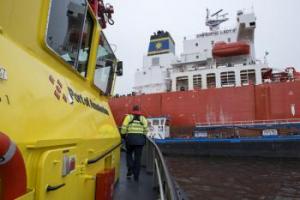Harbour Master
Harbour Masters
Worldwide there are approximately 3,000 merchant ports and the work of the Harbour Master can vary widely from country to country and from port to port even within the same country.


Due to environmental aspects, lack of available typical onshore marine facilities like harbours, docks or quays, risk-related issues or other cost and schedule constraints, locations of oil and gas, solid bulks and even passenger terminals can be in isolated areas requiring the use of Single or Multi Point Mooring (SPM or MPM) terminals located offshore close to the coastline. Vessels can connect to these facilities for the loading/offloading of goods and passengers.
SPM facilities are primarily linked to the oil and gas industry while MPMs are used for those and other cargoes.
This document provides guidelines and recommendations for the safe design and assessment of SPM and MPM terminals for the global community. This document should be read in conjunction with relevant guidelines on the same matter (i.e. ABI, OCIMF, DNV, etc.) where more elaborate information is provided with regards to each topic.
Users will find references to these other guidelines on each particular section.
Liquid and gas transfer infrastructure
The guidelines provided in this document focus on the infrastructure associated with facilities depicted in Table 1-1 used in the transfer of oil and gas, bulk liquids or any other cargoes likely to be handled at these types of marine facilities, including ferries and other cruise and passenger ships.
Ship terminal interface
In the case of oil and gas terminals the scope includes the loading/unloading systems, because the supply of SPMs and MBMs usually covers all components from the ship/terminal interface up to the submarine pipeline (PLEM).
In the case of other cargoes, loading and/or unloading equipment typically uses ships’ gear or other floating equipment and is covered by this document.
A uniform set of recommendations
The purpose of this document is to provide a uniform set of recommendations for the design, analysis and maintenance of new SPM/MBM loading/offloading terminals as well as rehabilitation/upgrade and decommissioning of existing facilities.
The main objective of this document is to provide guidance based on good industry practice. The guidance provided is focused on a risk-based approach to the design, fabrication, installation, operation and maintenance of the facility.
These guidelines are applicable to Catenary Anchor Leg Moorings (CALM), Single Anchor Leg Moorings (SALM), Fixed Tower Systems, Multi Buoy Mooring Systems (MBM), Spread Mooring Systems (SMS) and other concepts such as Tandem Offloading– together with combined multi buoy and landside bollards as used in some bulk/passenger loading scenarios.
Pipelines, ships and ships’ equipment are excluded.
About PIANC
PIANC is the global organisation providing guidance and technical advice for a sustainable waterborne transport infrastructure to ports and waterways.
Established in 1885, PIANC unites the international experts for technical, economic, and environmental topics related to waterborne transport. Our members include national governments and public authorities, corporations, industry and academic experts and young and experienced professionals.
For further information, readers are invited to contact the PIANC General Secretariat at: info@pianc.org
The International Harbour Masters Association (IHMA) and the Port of Rotterdam Authority are pleased to announce the 15th International Harbour Masters Association Congress, to be held from 09–12 June 2026 at Theater Zuidplein in Rotterdam.
Naresh Sewnath, Senior Harbour Master at Transnet National Ports Authority (TNPA) in South Africa’s Port of Durban, began his maritime career back in 1988. He started out as a cadet with TNPA (then known as South African Transport Services (SATS).